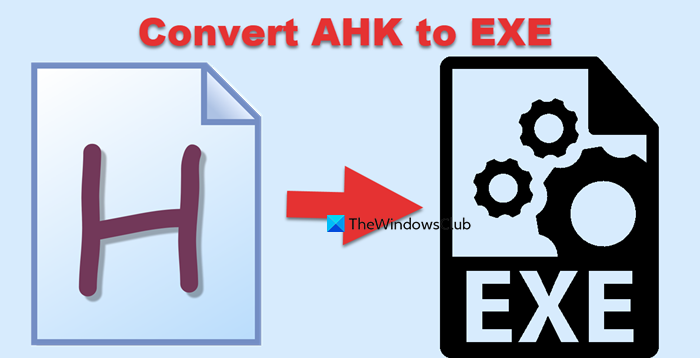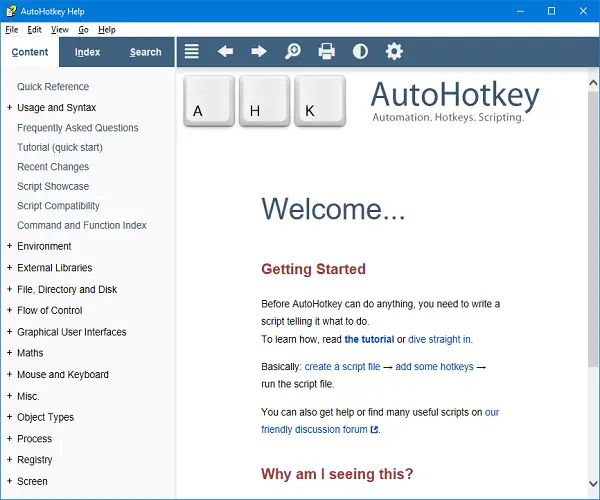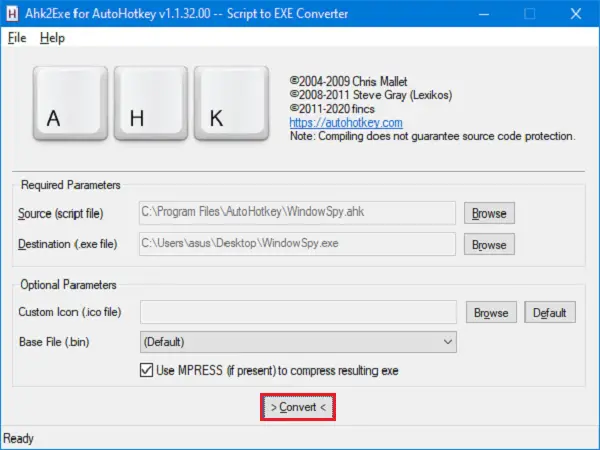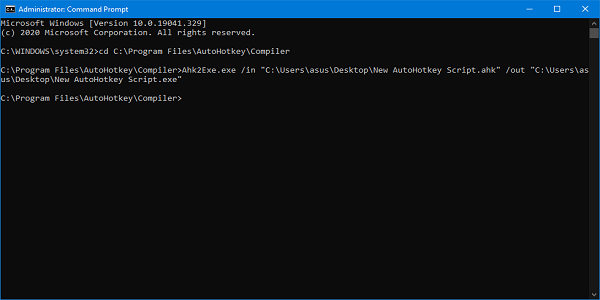AutoHotKey or AHK files are plain text file type that’s used by AutoHotkey, a free scripting tool for automating tasks in Windows. Whereas, EXE extension is used for executable files that can be executed by the operating system or by a software application. In this post, we will learn how to convert an AHK file into an EXE file in Windows 11/10.

Sometimes AutoHotkey scripts also contain hotkeys (keyboard shortcuts) and hotstrings, which can automatically replace certain text strings when typing. If we take an example to explain, it’s just like SpellChecker and AutoCorrect on our phones. In this article, we will learn how to convert these .AHK file into an .EXE file using AutoHotKey in Windows 11/10.

Scripts are somewhat like small programs that run a series of commands and can accept input from a user. They’re mostly used to automate repetitive tasks. AutoHotKey scripts have a wide range of uses. These scripts are quite capable of something basic like remapping keys, to more complex operations like renaming and/or moving files and creating directories, they Mostly like batch scripts but more than that, these scripts have their niche function and are popular on Windows.
Convert AHK file to EXE file
Now, to convert AHK files you need to download the AutoHotkey application and install it on your system. There are two ways by which you can easily convert the files.
- Using Ahk2Exe for AutoHotKey
- Using Command Prompt
1] Using Ahk2Exe for AutoHotKey

We know that running AutoHotKey scripts is pretty difficult to execute but it is way better to run them as an executable.
- Go to the Start Menu and open up Convert .ahk to .exe.
- In the Required Parameters section, click on Browse for Source (script file).
- Select the .AHK file you want to convert to an executable .EXE file.
- Now click on Browse for Destination (.exe file).
- Select the folder where you want to keep the file after conversion. Make sure to enter the File Name while choosing the destination.
- Click on Convert.
You can choose from certain Optional Parameters like choosing custom icon files and encoding methods.
Read: How to convert DXF to GCode.
2] Using Command Prompt
Using Command Prompt for day-to-day work is a real deal, you understand how things work. For converting scripts using the command prompt, you still need the AutoHotKey application installed on your system.
Go to the start menu, type cmd, and open Command Prompt as Administrator.
Navigate to AutoHotKey application folder using:
cd C:\Program Files\AutoHotkey\Compiler
Enter the following command to convert the file:
Ahk2Exe.exe /in "location of file with filename.ahk" /out "location of file with filename.exe"
To convert the file along with a new icon, use the following command:
Ahk2Exe.exe /in "location of file with filename.ahk" /out "location of file with filename.exe" /icon "location of icon"

Make sure to include file names in the location along with their file extension.
To know more about how to use AutoHotKey scripts and their conversions, you can use the application or read it here. The application and website also cover the method of how you can create .AHK script.
Since, you are trying to convert any .AHK file which is present in any secured folder, this process may throw an error. Even if the Command Prompt is running in Administrator mode, you need to move the script file to the position where read/write operations are allowed.
If your converted EXE file is not working then make sure the script file has no errors and is syntactically correct.
Read: How to Convert WMA to MP3 file format.
How to convert AHK file to exe?
If when AutoHotKey is installed, you have selected Script Compiler option, you can run the hotkey script by right-clicking on a the .AHK file and selecting Compile Script. This will create an executable file at the same location with the actual name of the file.
How do I run an AutoHotkey script on startup Windows 11?
You can place the AutoHotKey script in the Startup folder to run it on startup in Windows 11. To do the same, copy the file, open Run by Win + R, enter shell:startup, click Ok, and then paste the file. This will allow Windows to run the script every time your system boots up.
Also Read: Free Keyboard Shortcut software to customize and change keyboard shortcuts.